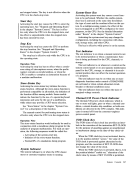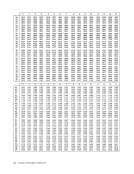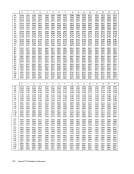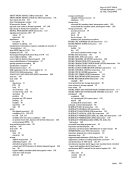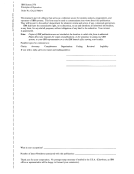command chaining is specified or when command
retry is performed. Whether or not multiplexing oc
curs between blocks depends on the state of the
block-multiplexing control bit, the design of theI/O device, and, on some models, whether the subchan
nel is shared or nonshared.
The mUltiplexing capability of a block-multiplexer
channel is under control of the block multiplexing
control bit, bit0 of control register O. When this bit
is zero, multiplexing is inhibited, and when it is one,
multiplexing is allowed.
Whether a block-multiplexer channel executes anI/O operation with multiplexing inhibited or allowed
is determined by the state of the block multiplexing
control bit at the time the operation is initiated by
ST ARTI/O or START I/O FAST RELEASE and
applies to that operation until the involved sub chan
nel becomes available.
Both byte-multiplexer and block-multiplexer
channels vary in the number of subchannels they
contain. When multiplexing, they can sustain concur
rently oneI/O operation per subchannel, provided
that the total load on the channel does not exceed its
capacity.Each subchannel appears to the program as
an independent selector channel, except in those
aspects of communication that pertain to the physi
cal channel (for example, individual subchannels on
a multiplexer channel are not distinguished as such
by the TEST CHANNEL instruction or by the
masks controllingI/O interruptions from the chan
nel). When a multiplexer channel is not servicing anI/O device, it monitors its devices for data and for
interruption conditions.
When a multiplexer channel is transferring data in
burst mode, the sub channel associated with the burst
operation monopolizes the data-transfer facilities of
the channel.Other subchannels on the multiplexer
channel cannot respond to requests from devices
until the burst is completed.
Subchannels on a multiplexer channel may be
either nonshared or shared.
A sub channel is referred to as nonshared if it is
associated and can be used only with a singleI/O device. A nonshared sub channel is used with devices
that do not have any restrictions on the concurrency
of channel program operations, such as the IBM
3211Printer Modell or one drive of a 3330 Disk
Storage.
A subchannel is referred to as shared if data
transfer to or from a set of devices implies the use of
the same subchannel.Only one device associated
with a shared subchannel may be involved in data
transmission at a time. Shared subchannels are used
with devices, such as magnetic tape units or some
disk-access mechanisms, that share a control unit.
For such devices, the sharing of the subchannel does
not restrict the concurrency ofI/O operations since
the control unit permits only one device to be in
volved in a data-transfer operation at a time.I/O devices may share a control unit without necessarily
sharing a sub channel. For example, each transmis
sion line attached to the IBM2702 Transmission
Control is assigned a nonshared subchannel, al
though all of the transmission lines share the com
mon control unit.
Programming Note
A block-multiplexer channel can be made to operate
as a selector channel by the appropriate setting of
the block multiplexing control bit. However, since a
block-multiplexer channel inherently can interleave
the execution of multipleI/O operations and since
the state of the block multiplexing control bit can be
changed at any time, it is possible to have one or
more operations that permit multiplexing and an
operation that inhibits multiplexing being executed
simultaneously by a channel.
Therefore, to ensure complete compatibility with
selector channel operation, all operational sub chan
nels on the block-multiplexer channel must be avail
able or operating with multiplexing inhibited when
the use of that channel as a selector channel is be
gun. All subsequent operations should then be initi
ated with the block multiplexing control bit inhibit
ing mUltiplexing.
System Operation
Input/ output operations are initiated and controlled
by information with three types of formats: instruc
tions, channel command words (CCWs), and orders.
Instructions are decoded by theCPU and are part of
theCPU program. CCWs are decoded and executed
by the channels andI/O devices, and initiate I/O operations, such as reading and writing. One or more
CCWs arranged for sequential execution form a
channel program. Both instructions and CCWs are
fetched from main storage and their formats are
common for all types ofI/O devices, although the
modifier bits in the command code of a CCW may
specify device-dependent conditions for the execu
tion of an operation at the device.
Functions peculiar to a device, such as rewinding
tape or positioning the access mechanism on a disk
drive, are specified by orders.Orders are decoded
and executed byI/O devices. The control informa
tion specifying an order may appear in the modifier
bits of a control-CCW command code, may be trans
ferred to the device as data during a control or write
operation, or may be made available to the device by
other means.
Input/Output Operations 189
retry is performed. Whether or not multiplexing oc
curs between blocks depends on the state of the
block-multiplexing control bit, the design of the
nel is shared or nonshared.
The mUltiplexing capability of a block-multiplexer
channel is under control of the block multiplexing
control bit, bit
is zero, multiplexing is inhibited, and when it is one,
multiplexing is allowed.
Whether a block-multiplexer channel executes an
is determined by the state of the block multiplexing
control bit at the time the operation is initiated by
ST ART
applies to that operation until the involved sub chan
nel becomes available.
Both byte-multiplexer and block-multiplexer
channels vary in the number of subchannels they
contain. When multiplexing, they can sustain concur
rently one
that the total load on the channel does not exceed its
capacity.
an independent selector channel, except in those
aspects of communication that pertain to the physi
cal channel (for example, individual subchannels on
a multiplexer channel are not distinguished as such
by the TEST CHANNEL instruction or by the
masks controlling
nel). When a multiplexer channel is not servicing an
interruption conditions.
When a multiplexer channel is transferring data in
burst mode, the sub channel associated with the burst
operation monopolizes the data-transfer facilities of
the channel.
channel cannot respond to requests from devices
until the burst is completed.
Subchannels on a multiplexer channel may be
either nonshared or shared.
A sub channel is referred to as nonshared if it is
associated and can be used only with a single
that do not have any restrictions on the concurrency
of channel program operations, such as the IBM
3211
Storage.
A subchannel is referred to as shared if data
transfer to or from a set of devices implies the use of
the same subchannel.
with a shared subchannel may be involved in data
transmission at a time. Shared subchannels are used
with devices, such as magnetic tape units or some
disk-access mechanisms, that share a control unit.
For such devices, the sharing of the subchannel does
not restrict the concurrency of
the control unit permits only one device to be in
volved in a data-transfer operation at a time.
sharing a sub channel. For example, each transmis
sion line attached to the IBM
Control is assigned a nonshared subchannel, al
though all of the transmission lines share the com
mon control unit.
Programming Note
A block-multiplexer channel can be made to operate
as a selector channel by the appropriate setting of
the block multiplexing control bit. However, since a
block-multiplexer channel inherently can interleave
the execution of multiple
the state of the block multiplexing control bit can be
changed at any time, it is possible to have one or
more operations that permit multiplexing and an
operation that inhibits multiplexing being executed
simultaneously by a channel.
Therefore, to ensure complete compatibility with
selector channel operation, all operational sub chan
nels on the block-multiplexer channel must be avail
able or operating with multiplexing inhibited when
the use of that channel as a selector channel is be
gun. All subsequent operations should then be initi
ated with the block multiplexing control bit inhibit
ing mUltiplexing.
System Operation
Input/ output operations are initiated and controlled
by information with three types of formats: instruc
tions, channel command words (CCWs), and orders.
Instructions are decoded by the
the
by the channels and
CCWs arranged for sequential execution form a
channel program. Both instructions and CCWs are
fetched from main storage and their formats are
common for all types of
modifier bits in the command code of a CCW may
specify device-dependent conditions for the execu
tion of an operation at the device.
Functions peculiar to a device, such as rewinding
tape or positioning the access mechanism on a disk
drive, are specified by orders.
and executed by
tion specifying an order may appear in the modifier
bits of a control-CCW command code, may be trans
ferred to the device as data during a control or write
operation, or may be made available to the device by
other means.
Input/Output Operations 189
























































































































































































































































